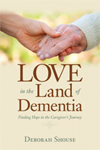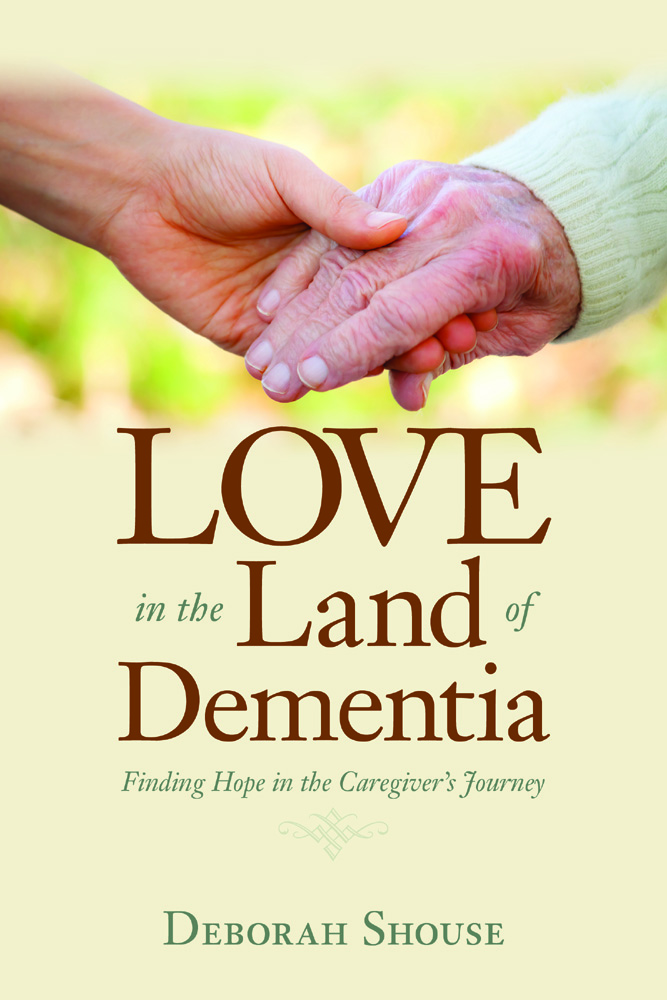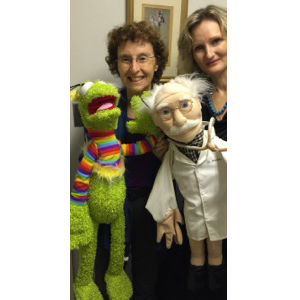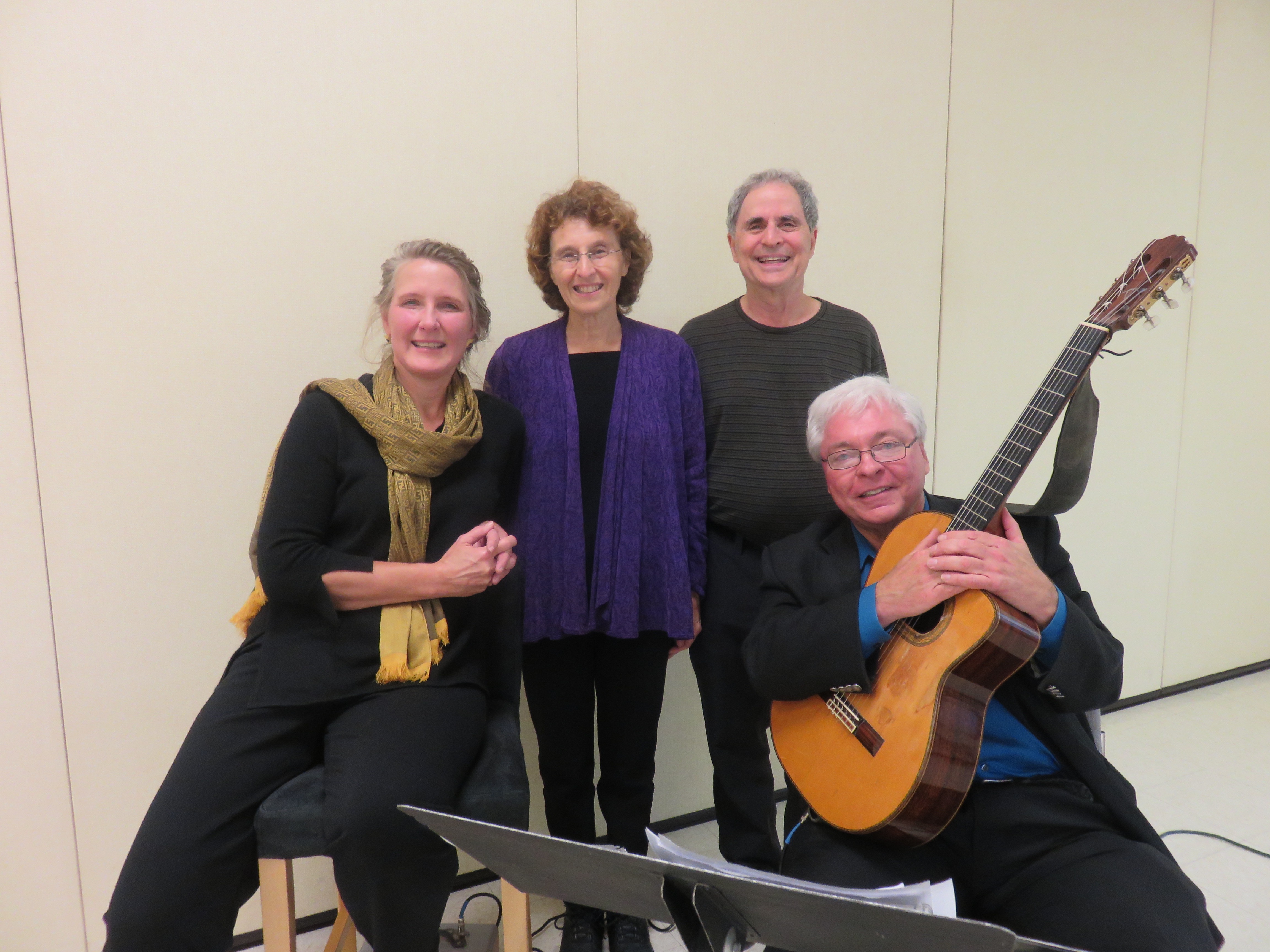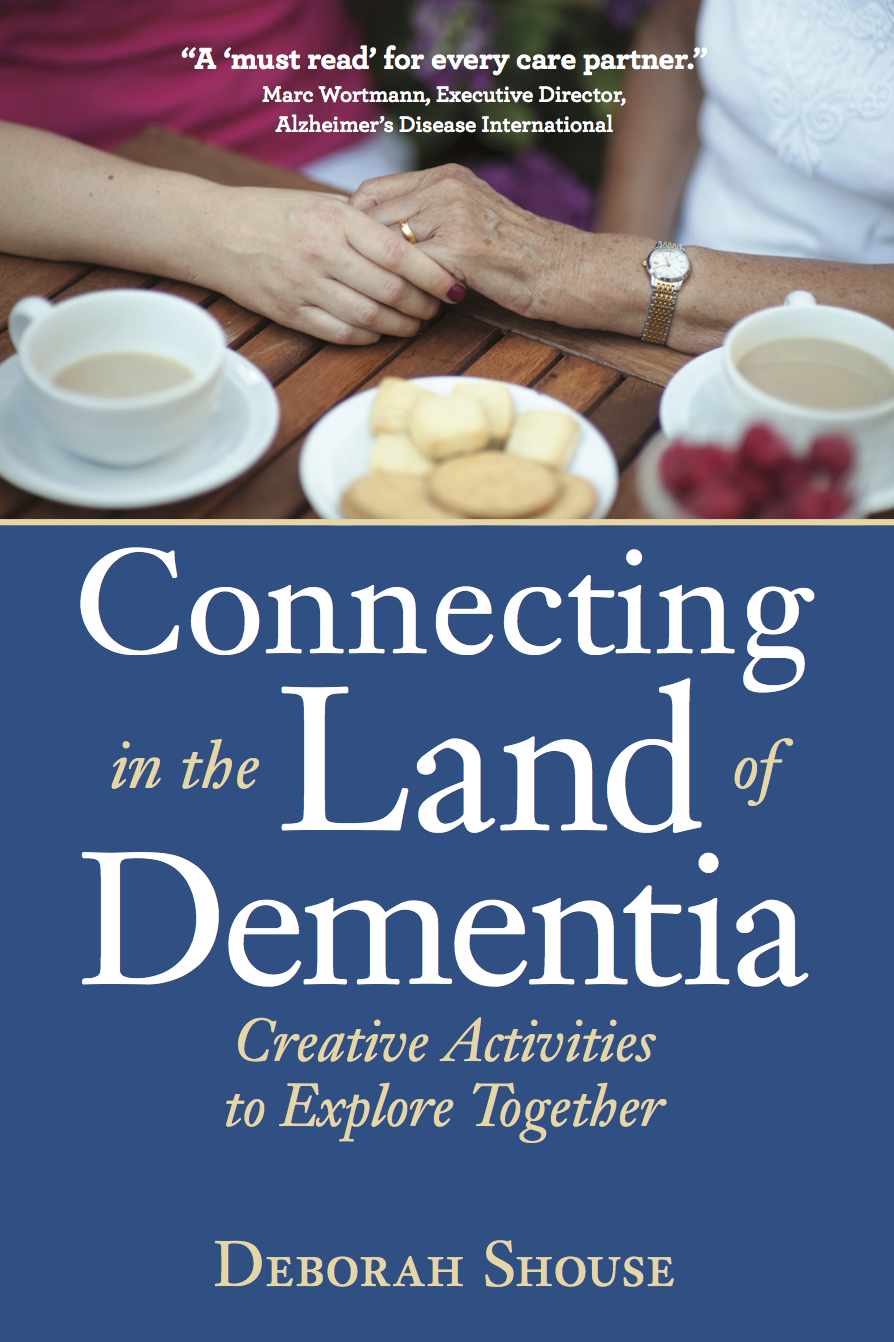Posts Tagged ‘alzheimer’s’
Tuning into Music for Connection: Helping Children Accept Dementia
“Oh what a beautiful morning,” I warbled. My mom clapped and hummed along. At the end of the song, she applauded. In her earlier days of motherhood, she might have winced slightly when I wandered off-key. But in the cradle of dementia, she was delighted with my smile, my energy, and the sheer sound of my voice. And I was delighted to be tuning into music for connection.
Carol Bradley Bursack, an author, speaker, family care partner and creator of Minding Our Elders, recently told me the story of how she helped her teenage children stay connected with their grandfather. I loved her ideas and wanted to share her tips with you.
Tuning into Music for Connection
When he was in his 70s, Carol’s father went into surgery to help repair brain damage from a World War II injury. The doctors expected no issues, but during the operation, something went awry. Her beloved father emerged from the procedure deep in dementia, with a constant voice in his head, and no grasp of reality. Valiantly, Carol dealt with her anger and grief while finding a safe and compassionate care community for her father. Then she began searching out ways she and her sons could stay connected with him.
“Dad loved big band music,” Carol says. “I bought every CD I could find. He loved to direct and listen to the music.”
Finding a Musical Bridge
Carol’s sons were very close to their grandfather. He had always been there for them, a vibrant, fun presence, celebrating their abilities, playing chess with them, and listening to their stories. When her sons saw that Grandfather was so changed he couldn’t even hug them and no longer understood the chessboard, they were devastated.
“They didn’t know how to bond with him,” Carol says.
Carol understood their reluctance to visit and gave them some space. She didn’t make the children feel guilty about their feelings, but she did want them to maintain a relationship with their grandfather. Tuning into music for connection came to the rescue.
The boys both played instruments and Carol urged them to take their clarinet and trumpet to the care community. At first, they were hesitant. They stood shyly before this new grandfather, barely able to blow out the notes. But at the end of their first short tune, Grandfather beamed and asked for an encore. The boys grinned and played more confidently. People came from down the hallways, wanting to hear the music.
“The boys and their music had made a connection,” Carol says. “All three of them were happy and relaxed.”
Creating Together to Build Connection
Carol continued to seek ways to help her sons feel comfortable during their visits. She also wanted them to feel a sense of accomplishment and to cherish their relationship with their grandfather.
Sometimes the boys took hand-drawn pictures to decorate the walls. Other times, they showed up with examples of science projects and told their grandpa about them. The boys brought chess pieces, old photos from Grandpa’s younger days, and games that they’d played with Grandpa. They invited their grandfather to share stories about these objects and often he did.
“It’s hard for young minds to accept such changes,” Carol says. “Their grief can slide under the radar. I was constantly looking for activities we could share, projects that were mutually engaging and that Grandpa could understand.”
Through it all, their mutual love of music kept them together.
For more information on the important work Carol is doing, visit her website: www.mindingourelders.com.
And treat yourself to her book, Minding Our Elders.
Deborah Shouse is the author of Connecting in the Land of Dementia: Creative Activities to Explore Together and Love in the Land of Dementia: Finding Hope in the Caregiver’s Journey.
Using Creativity to Live Successfully with Dementia
“Creativity is evident in every one of us,” says Michelle Niedens, Director of Education, Programs and Public Policy, Alzheimer’s Association Heart of America Chapter. Every time I hear Michelle talk about the creative aspects of living with dementia, I am moved. I was so honored to have Michelle speak at my book launch for Connecting in the Land of Dementia. I treasured what she said about using creativity to live successfully with dementia and I asked if she would allow me to share her words of wisdom and caring with you. Here is her beautiful talk.
Using Creativity to Live Successfully with Dementia
by Michelle Niedens
It has been said that “we are helped by what is not, to use what is”. In Alzheimer’s disease, there are some things that are not. But welcoming this philosophy of using what is allows us to explore all the parts that are. As part of projects focusing on creativity at the Alzheimer’s Association, I have heard many people talk about how they are not creative. In one way or another, they find a way to let me know they believe they cannot create art, or stories or a collage or whatever forms of creation lay before them. Yet if we allow our minds to really think about the place of creativity in our lives, we could make a case that it is evident in every one of us. Whether it be building book shelves, writing poetry, the way we frame our words in conversation, the way we problem solve, the way we play with children, the way we garden and even the way we convince ourselves of things. Life is both complicated and simple and requires creativity to survive. It is almost as ever present as thought and breath.
In the poem, “the Necessary Art of Salvaging”, Barbara Lau writes;
Enjoy Dementia Inclusive Holiday Cooking
“Who prepared this delicious meal?” a friend asked during a holiday dinner.
I named my brother Dan, our head chef, first. Then I included the support team—myself, my mom, my daughters and nephews.
“Did I help?” Mom whispered as I passed her the mashed potatoes.
“You sure did,” I told her. ”You mashed the potatoes, put the marshmallows on the sweet potato casserole, and mixed the fruit salad.”
“That’s good,” she said. “I like to help.”
Our desire to help and contribute to seasonal celebrations doesn’t end with a diagnosis of dementia. It’s lovely to linger in the kitchen together, preparing food for the holidays. It’s even lovelier when you can adapt and enjoy dementia inclusive holiday cooking so that people of varying abilities can participate.
Rebecca Katz, author of The Healthy Mind Cookbook, sees food as a great equalizer, something anyone can enjoy regardless of abilities. Fixing a delicacy for someone offers a tangible and delicious way to give back.
Here are some tips so you can enjoy dementia inclusive holiday cooking.
- Leaf through a favorite family cookbook or recipe box and use the pictures and recipes as a catalyst for conversation. Ask open-ended questions, such as, ”What does that brownie recipe make you think of?” “What do you like about the holiday season?”
- Select a special recipe to make together. Choose simple, safe and satisfying tasks, such as measuring, adding ingredients , stirring, and tasting.
- Chose a time of day when you’re both rested.
- Create a comfortable kitchen environment, by playing familiar seasonal songs you can both hum or sing along to. Reduce extraneous noise and distractions, such as a television in the background.
- If you wish, take photos during the experience. That way, you can relive the adventure and share with family and friends.
- Indulge in instant gratification, if possible, by sampling your work when the cooking is complete.
- Even if the person living with dementia can’t help prepare food, he can still enjoy sitting in on the action and the conversation.
Whether you’re stirring a pot of orzo or dropping mint leaves into cool water, enjoy your time of creation and connection in the kitchen.
A longer version of this piece originally appeared on Joan Lunden’s excellent website: Enjoy Dementia Inclusive Holiday Cooking. Thanks to Sue Fitzsimmons, MS, ARNP, Judith Fertig, author of The Memory of Lemon, Kate Pierce, LMSW, Alzheimer’s Association Greater Michigan Chapter, and Rebecca Katz, author of The Healthy Mind Cookbook
Deborah Shouse is the author of Connecting in the Land of Dementia: Creative Activities to Explore Together and Love in the Land of Dementia: Finding Hope in the Caregiver’s Journey.
Paradise Lost and Found: Two Women Take Action on Alzheimer’s
Like most visitors to Bermuda, we were interested in the lush sand beaches and warm tourmaline ocean waters. But we were also interested in meeting Liz Stewart and Marie Fay of Action on Alzheimer's. These two women are using their considerable energies, connections, and talents to enrich the lives of Bermudians who are living with dementia. Liz and Marie inspired us with their passion and accomplishments and we wanted you to meet them as well.
~~~~~~~~~
"Now what?"
That was the question Liz Stewart asked after her mother was diagnosed with dementia. It was 2004 in Bermuda and Liz could not find any support services for herself or her mom. She was thrust into the care partner's role without any education on the subject of dementia. Liz knew, "It's not what you know; it's what you can learn," and Liz began learning fast. She soon realized she was not alone. In Bermuda, there were hundreds of people living with dementia. Liz's quest to help her mother turned into a determination to help others living with dementia. She formed a non-profit organization, Action on Alzheimer's, in late 2012. She volunteers her time and works with Marie Fay, an occupational therapist with special dementia training, offering support services, education, and training throughout the islands.
 Liz and Marie are a two-woman transformation team who have gathered other like-minded people.
Liz and Marie are a two-woman transformation team who have gathered other like-minded people.
They provide free dementia training to the island's care communities, hospitals, doctors, and families. They collaborate with local musicians and movement specialists and host frequent expressive arts sessions, including drumming, movement, and singing. They work with government officials, advocating for those who need more resources. And they are talking about the issues, raising consciousness through Alzheimer's Awareness runs, wine-tasting fundraisings, and community events.
Now, when someone is diagnosed with dementia on Bermuda, they don't have to feel totally isolated and confused. They can turn to Action on Alzheimer's.
If you know of other people who are making a difference, please let me know. I love being inspired by the passion and compassion of world-changing souls.
To learn more about Action on Alzheimer’s, visit www.alzbermuda.com

Deborah Shouse is the author of Connecting in the Land of Dementia: Creative Activities to Explore Together and Love in the Land of Dementia: Finding Hope in the Caregiver’s Journey.
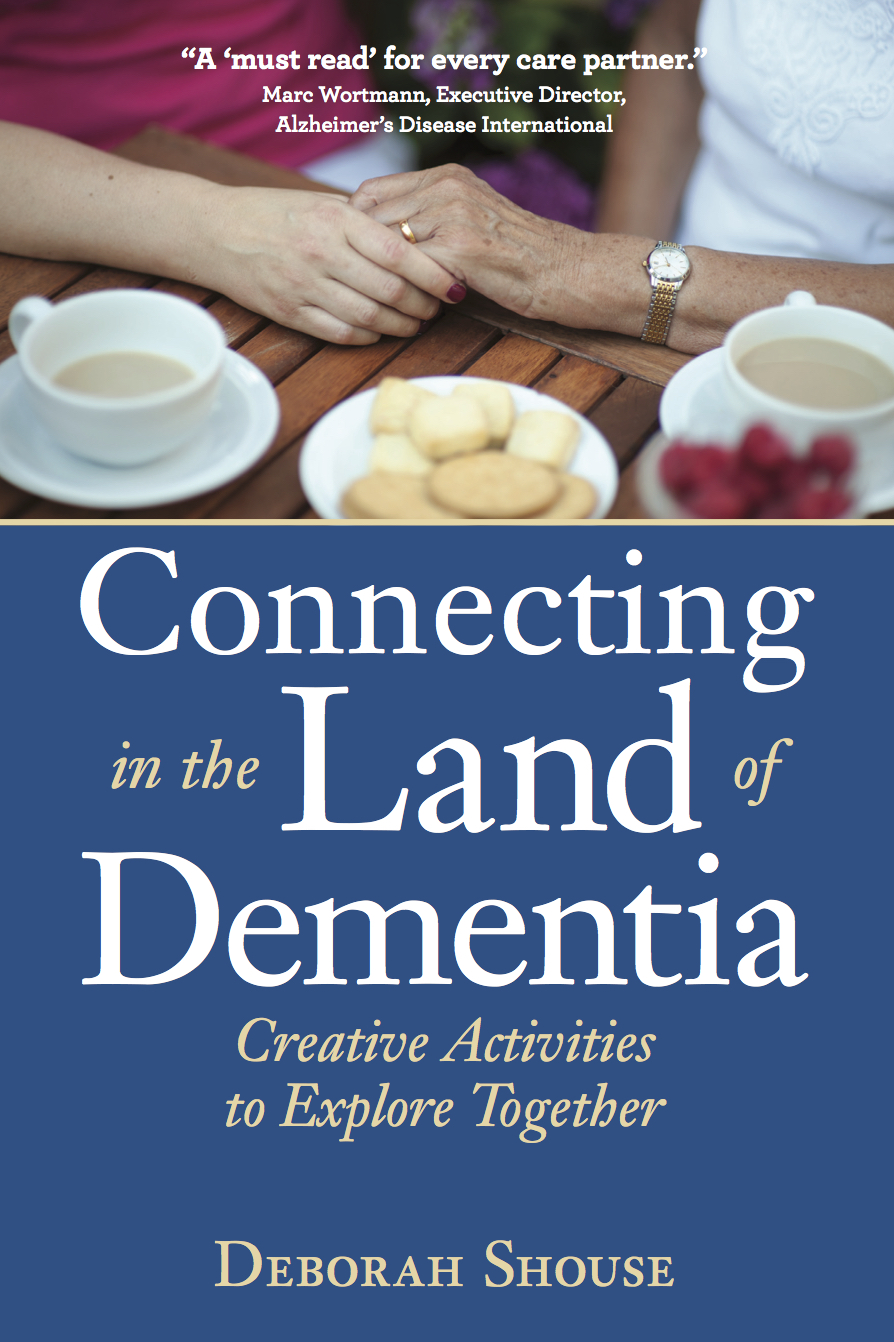
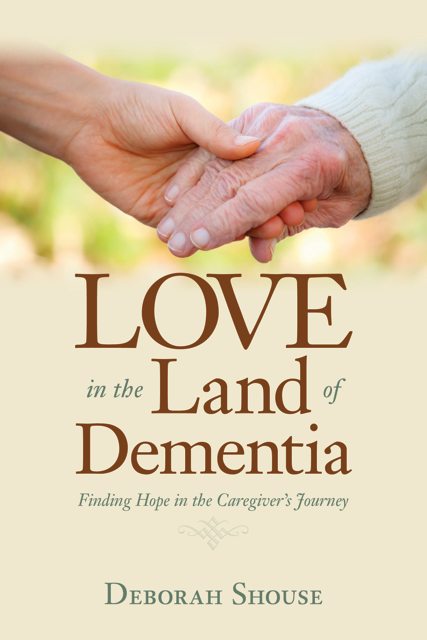
An Inside Look at Creative Aging
We are huddled on the floor, concentrating on our assignment. Each of us has shared an important saying or proverb that impacted our lives and now we are turning those six sayings into a song. We have a daunting five minutes to accomplish this creative task. However, we also have songwriter and musician Vanessa Torres from Lifesongs to guide us. After we've shared our sayings, Vanessa instantly comes up with a theme--These Are Things That I've Learned. Our song centers around that chorus, with each of us weaving in our personal sayings.
In the other three corners of the room, groups are collaborating, turning their sayings into spoken word, dramatic movement, and theatrical improv. Our facilitator, Susan Pearlstein, Founder Emeritus for the National Center for Creative Aging in Washington, DC, and the Founder of Elders Share the Arts in New York City, calls us back to the circle and each group performs their piece. In mere minutes, we have learned something important about each person, we have created an artistic work with people we're just getting to know, and we have appreciated the power of creating something together.
This was an exhilarating beginning to the third annual NCCA conference on creative aging.
These are things I that learned at the conference:
 Every person is inherently creative. Of course, I knew this. But it is so lovely to be reminded in so many ways. It is so lovely to be invited more deeply into your own creativity through song, dance, theater games, art, movement, and brainstorming. It's inspiring to be in a room where so many are expressively at ease with their creative spirits.
Every person is inherently creative. Of course, I knew this. But it is so lovely to be reminded in so many ways. It is so lovely to be invited more deeply into your own creativity through song, dance, theater games, art, movement, and brainstorming. It's inspiring to be in a room where so many are expressively at ease with their creative spirits.
Here are some insights from conference luminaries. Some are not attributed because I was so raptly listening I didn’t write everything down!
“Creativity is a moment when we look at the ordinary, but see the extraordinary.”
“Art is for everyone. It's not a frivolous add-on. It's a vital part of life. Everyone is creative. Dream and dispel the myth that ‘I can't do art.’ Aging has been treated like it’s all gray but it's really expansive colors.” Remarks of Jane Chu, Chairman of the National Endowment for the Arts, Sept 25th, 2016. Click here to enjoy a video of the Chairman
“Feeling useful is a human right.”
“Fifty percent of our elders feel lonely.” Vice Mayor Karsten Klein, The Hague
"By listening closely to one another, we can help illuminate the true character of this nation, reminding us all just how precious each day can be and how great it is to be alive." Dave Isay, founder of StoryCorps, via Eddie Gonzalez
“Bringing what is inside to the outside; it is important to do this as we age.” Mary Luehrsen, National Association of Music Merchants
“Creativity is the connective tissue that we use to build community across diverse differences.” Anne Basting, TimeSlips, ™ Recipient of a 2016 MacArthur Genius Grant
“Instructors need people living with dementia as co-teachers to transform educational goals. “ Dr. Elizabeth Lokon, Opening Minds Through Art
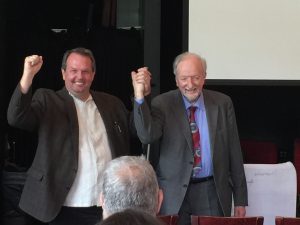
John Killick (right), poet, author and innovator in creativity and dementia, heard this wisdom one day while visiting a memory care community:
“Words of comfort are free, but very necessary.”
“I love it when you hold out your hand and water pours from it.”
“If you don't ask for the moon, you don't even get a piece of cheese.”
“You have to introduce yourself or else it all goes brittle.”
“Life is the slackness, the film and the veil.”
“Every time I look for home, I find you.”
John says, “This tells me that people with dementia are really creative and all we have to do is listen and be enriched.
This is just a soupçon of things that I learned. I wish I could have talked to every person at the conference. I wish I could have listened full on to their stories, to their sayings and proverbs, to the things that they knew and the things they had learned. Which is one reason I hope to return to the conference next year.
Deborah Shouse is the author of Connecting in the Land of Dementia: Creative Activities to Explore Together and Love in the Land of Dementia: Finding Hope in the Caregiver’s Journey.
Therapeutic Puppetry: The Best Rx is Smiles
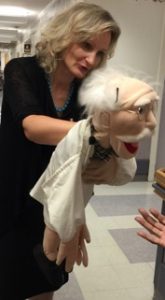 I’ve met a lot of doctors whom I admire, due to their intelligence, listening skills, willingness to collaborate, and their ability to have the occasional hearty laugh. Recently Veronica Kaninska, Certified Therapeutic Recreation Specialist, introduced me to a Doc I instantly fell in love with.
I’ve met a lot of doctors whom I admire, due to their intelligence, listening skills, willingness to collaborate, and their ability to have the occasional hearty laugh. Recently Veronica Kaninska, Certified Therapeutic Recreation Specialist, introduced me to a Doc I instantly fell in love with.
I went on rounds with Veronica and Dr. Moody, who often works with people who are living with dementia. I was so impressed with his knowledge of each individual and the warm way he offered his services. His first patient lit up when he and Veronica strolled toward her.
"How are you today?" he asked in a friendly avuncular voice. "Dr. Moody is here to check your mood. Are you feeling happy?"
"Yes, Dr. Moody, I'm happy now that you're here."
"Let me check your smile."
She smiled broadly and Dr. Moody nodded approvingly.
"Let me see your eyes."
She widened her eyes.
"Good. Your eyes are sparkling. I hope you keep your happy mood all day."
"I will Dr. Moody, I will."
We continued with Dr. Moody checking on some more patients. Each one enjoyed his company and he promised to come again and check on their moods.
After rounds, Veronica slid Dr. Moody off her arm and hung him near another popular puppet, Froggie, who she also uses for therapeutic purposes.
"People who are living with dementia often feel very comfortable communicating with puppets," Veronica says.
I wondered if Dr. Moody was open to new patients and Veronica assured me he was.
Click here to meet the good doctor. 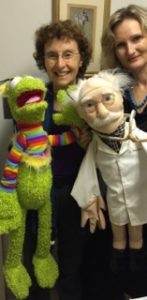
"Puppets break down barriers,” Veronica says. "They have no religion, no gender, and no judgment. People living with dementia often feel comfortable confiding in a puppet."
In a space of three to five minutes, I saw Veronica and Dr. M transform the energy of the people they visited. I asked Veronica to share a few tips for using puppets.
If you'd like to know more about Veronica and her work, read her chapter in Connecting in the Land of Dementia.
Deborah Shouse is the author of Connecting in the Land of Dementia: Creative Activities to Explore Together and Love in the Land of Dementia: Finding Hope in the Caregiver’s Journey.
Shall We Dance?
 Normally, I do not like being the center of attention. But when Sebastian Tomkowski asked me to dance the merengue, I said yes. Actually, my first reply was, "I can't dance." But Sebastian assured me he would guide me, literally, every step of the way.
Normally, I do not like being the center of attention. But when Sebastian Tomkowski asked me to dance the merengue, I said yes. Actually, my first reply was, "I can't dance." But Sebastian assured me he would guide me, literally, every step of the way.
Sebastian is one of the dancers working with Rhythm Breaks Cares (RBC), a non-profit that specializes in bringing the energy and joy of ballroom dance to people who are living with dementia. We were lucky to experience one of RBC's sessions in a New York City care facility.
When everyone was gathered in a circle, Stine Moen, one of RBC's founders, put on some Frank Sinatra tunes. Instantly, one woman danced her way into the room. Her movements were graceful and stylish. When Sebastian invited her to waltz, she readily accepted.
Stine asked a seated women if she'd like to dance. The woman said, "I have this walker and I can't dance with it."
"You can," Stine assured her. "You can use your walker and you and I can dance together."
The woman demurred and sat swaying to the music. But when Stand by Me started playing, she hoisted herself to her feet, grabbed the walker, and began moving rhythmically around the room.
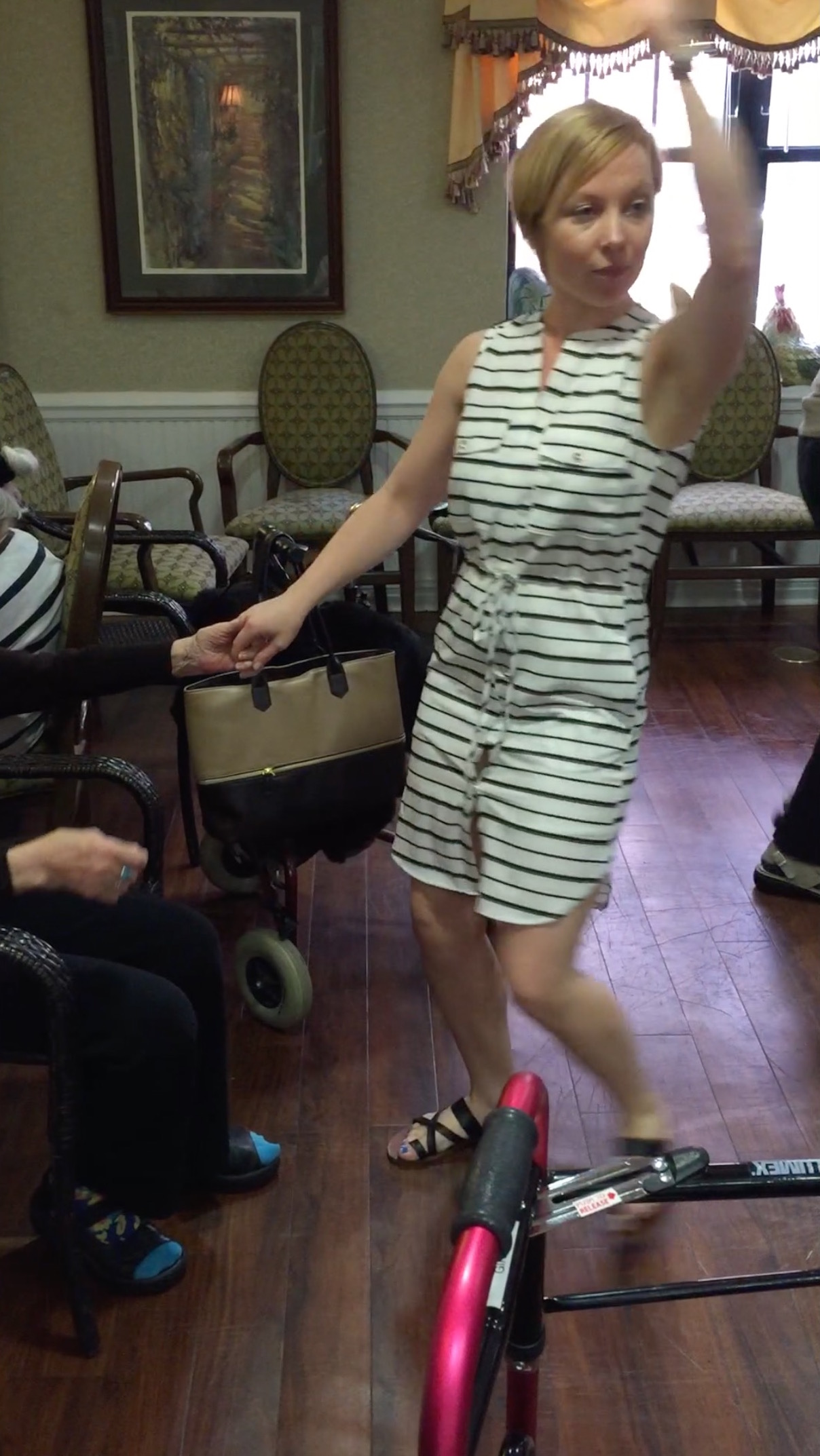 Two men sat in the circle, seemingly not registering the music. When Stine asked if they'd like to dance, one man held out his hand. Stine took his hand and let him guide the movements, while she made fancy arm gestures that looked as though they were waltzing in an elegant ballroom.Click here for dancing ideas.
Two men sat in the circle, seemingly not registering the music. When Stine asked if they'd like to dance, one man held out his hand. Stine took his hand and let him guide the movements, while she made fancy arm gestures that looked as though they were waltzing in an elegant ballroom.Click here for dancing ideas.
One woman sat stock still, but sang along when the song "Fever" played.
"I used to be a singer and my husband played the piano," she told me, when I sat beside her. "But I don't remember the words." She then proceeded to croon along with "I've Got You Under My Skin."
The energy from the music and movement seemed to engage everyone. Even a man who seemed immobile, his mouth tight, his hands clenched up near his face, gradually softened his expression and lowered his hands to his lap.As for me, I reveled in the experience, dancing with the residents or smiling and moving our hands in time to the music. And of course, I loved my once-in-a-lifetime merengue experience.
I asked Stine to offer a few tips for care partners who wanted more movement in their lives.
Here are her suggestions.
"We always start with the music." says Stine. "That sets the tone."
Once the music is playing, if possible, make eye contact. Then smile and hold out a hand. Move in ways appropriate to your partner’s abilities.
Celebrate every movement. Even swaying your arms together to the music is a form of dance.
“It's not about getting the steps right,” Stine says. “It's about connecting through music and movement.”
Want to learn more about the power of dance? Visit the RBC website. Good news—RBC offers training for qualified dancers, so they can bring this exciting program to their own communities.
Click here for additional tips from Stine.
Click here for tips from Sebastian.
Read more about creative programs in Connecting in the Land of Dementia: Creative Activities to Explore Together. Order your copy from your favorite independent or online bookstore.
Deborah Shouse is the author of Connecting in the Land of Dementia: Creative Activities to Explore Together and Love in the Land of Dementia: Finding Hope in the Caregiver’s Journey.

At Long Last: A Page-Turning Love Story
My hands trembled as I reached out my arms. For three long years I’d been working toward this meeting and yearning for this moment. Now, it was finally here. She was more beautiful than I had imagined, with a pleasing weight, just right for holding, just right for spending long hours with. From a glance, her personality seemed strong and purposeful and yet her warm, colorful exterior told me she would be easy to read. As she gradually opened up to me, I felt her power, her accessibility, her willingness to share ideas and wisdom. She felt great; she looked great; and she was brimming with exciting new ideas. Three long years and finally, she was in my arms. I hugged her tightly. At last I was holding my new book, Connecting in the Land of Dementia: Creative Activities to Explore Together
What makes this book unique? It’s the amazing people who contributed to it. During the writing process, I interviewed dozens of innovators across the globe, gathering ideas that engage the creative spirit so you can continue to experience meaningful moments throughout the dementia journey. These luminaries inspired me every step of the way and I am eager to share their ideas with you.
This book is brimming with easy projects using music, art, movies, cooking, gardening, and more. Here are some of the benefits you can look forward to when you do these activities together: Increased energy and socialization, an improved sense of purpose, reduced anxiety, and chances to express yourselves in new and meaningful ways.
Here’s even more good news about the ideas in this book. They’re adaptable for all ages and abilities, and you don’t need to have any special talents. Simply incorporate them into your daily routine and you’ll enrich your time together.
Marc Wortmann, Executive Director, Alzheimer’s Disease International, called the book “A ‘must read’ for every care partner because it really helps you to look at things differently!”
If you’re in the Kansas City area, please join us for the book launch on Sunday afternoon, October 9th, at 1:30 for a reception in the Truman Forum at the Plaza Library. The free presentation will begin at 2:00 This lively program, filled with ideas, stories, and songs, features myself and my partner Ron Zoglin, musical luminaries Rod Fleeman and Cynthia Schroer, and guest speaker Michelle Niedens from the Heart of America Chapter, Alzheimer’s Association.
RSVP 816-701-3407
For those of you in the Washington DC area, please join us at the free Alzheimer’s Foundation of America Caregiver’s Conference on Thursday September 29. We’ll be presenting there, along with other experts in the field. Click here to register.
We recently heard from several readers, saying, “This book is going to help so many people. I’m recommending it to my friends and colleagues.”
That’s what this is all about: enriching people’s lives through meaningful engagement.
It’s a challenge, bringing a new book into the world and we welcome your ideas and help in spreading the word about the book and the event.
You can order a copy now from Rainy Day Books, our book-seller for the event, or online.
Here is some advanced praise:
“A thoughtful and positive guide to the very thing I find myself constantly advocating to doctors, caregivers, and family members—social stimulation and creative arts will limit the need for psychiatric medication and improve the quality of life for those with dementia more than anything else.” Doug Wornell, MD, Life Solutions Group for Geriatric and Neurological Psychiatry
“Buy this book, read it, highlight what inspires you. As you make notes and bend pages to personalize this guide, you are creating a family treasure.” Carol Bradley Burdock, Founder of Minding Our Elders
“Deborah Shouse provides a great public service by shining light on the numerous creative activities that can meaningfully engage the minds and spirits of persons living with dementia. From personalized music to storytelling, Shouse makes it easy for caregivers to understand the various options they have to help their loved ones navigate through their everyday lives.” Dan Cohen, MSW Founding Executive Director, MUSIC & MEMORYsm
Three Benefits of Artistic Alchemy
Last week, I wrote about Julian West and his work with music and dementia. Hannah Zeilig, PhD, is an expert in culture, language, and dementia, who participated in and documented Julian’s program. When I interviewed Hannah, I was inspired by her perspective on arts and communications and wanted to share a few of her key ideas.
“The project showed us that you can converse in so many ways,” says Hannah. “The musicians and the dancer reminded us that we all can communicate without language.”
“One of the questions we’re asking in the UK is ‘How can the arts help with dementia? What can arts do that a game of dominoes cannot?’ ” Hannah says. “The arts help people become brave in how they connect with each other.”
The arts also transcend our dependence on achievement, identity, and memory.
“Being scared of dementia is the biggest barrier,” Hannah says. “In our language and our media, dementia is stigmatized and portrayed as catastrophic. One of the natural and common fears is summarized by this: ‘If I can’t remember where I live and my achievements, how do I know who I am?’
Julian’s work reminds us that we are all creative.
“People with dementia can be brimming with creativity and humor and able to make connections with each other,” Hannah says.
During one of Julian’s sessions, the musicians were playing and the dancer was cavorting around the circle. One resident, Alicia, walked right up, took the dancer’s hands and lead her in a waltz.
At the end of the dance, Alicia was glowing. She smiled and said, “We really just did something.”
And she was right.
….
Other gifts from this work in the arts:
- The residents communicated with more sounds and gestures.
- The staff saw the creative side of the residents.
- The creative atmosphere opened everyone up to alternate ways to connecting.
For more about Hannah and her work, visit:
Orchestrating a Musical Conversation
When Ron’s dad was living in a memory care unit, Ron and I talked with the residents and their families, learning about their favorite songs. We orchestrated a sing-along and had fun working with everyone and putting together a scrapbook of each resident’s special tunes. The combination of music and conversation created a sense of community for us all. Julian West, who we met on a recent trip to London, is creating community through engaging people in music and dance. We really love the way he weaves the two art forms together and wanted to share his easy and adaptable ideas with you.
Julian West had no idea what would happen at the care facility, but he trusted it would be something wonderful. An accomplished oboist and a teacher at the Royal Academy of Music, Julian assembled a violist, a composer, a dancer, and an artist to share energy and their art with people who are living with dementia.
“This was an experiment to see what could happen,” Julian says. “We worked completely improvisationally.”
Once a week, for eight weeks, the troupe came to the residential care home and created a living arts experience with residents and staff. They began by inviting everyone to choose a percussion instrument, such as rain sticks, bells, shakers, tambourine, etc.
“We had a musical conversation,” Julian says. “One person made a sound and another answered. We also chatted a lot. People commented on the music or expressed an emotion or impression.”
The musicians added their instruments and the staff and residents joined in, through percussion and voice. They made fascinating sounds, like an improv jazz singer might do. The dancer twirled around in the center of their circle. Her free movements gave the group a focal point and inspired others to explore various movements.
“I let go of preconceptions and tried to create an open atmosphere,” Julian says.
The artists’ openness helped the “conversation” grow and blossom.
One woman who was living with dementia held up a tambourine, keeping it still and gazing at it as though it were a beautiful and revered object.
Julian’s first thought was, “She doesn’t know it’s a musical instrument”.
“I let that thought go,” he says. “I saw how expressive she was. Her interaction with the tambourine was beautiful and profound and she allowed us all to see the instrument differently.”
Even if you don’t have your own musicians and dancers at home, you can still create this supportive and creative atmosphere.
- Share a few percussion instruments, put on some music you both like, and make some joyful noises. Experiment with bee-bop syllables to add a sense of freedom.
- After the song, talk about the experience, what you liked, what you felt, and any other impressions that came up.
- Consider inviting a “guest dancer,” someone who likes to move to music, or a child of a friend who’s taking dancing lessons. Go ahead and add your own moves.
- Invite friends and family to join you. You’ll have something to laugh, and sing, and talk about.
For more information about Julian’s work, visit: www.julianwest.co.uk
